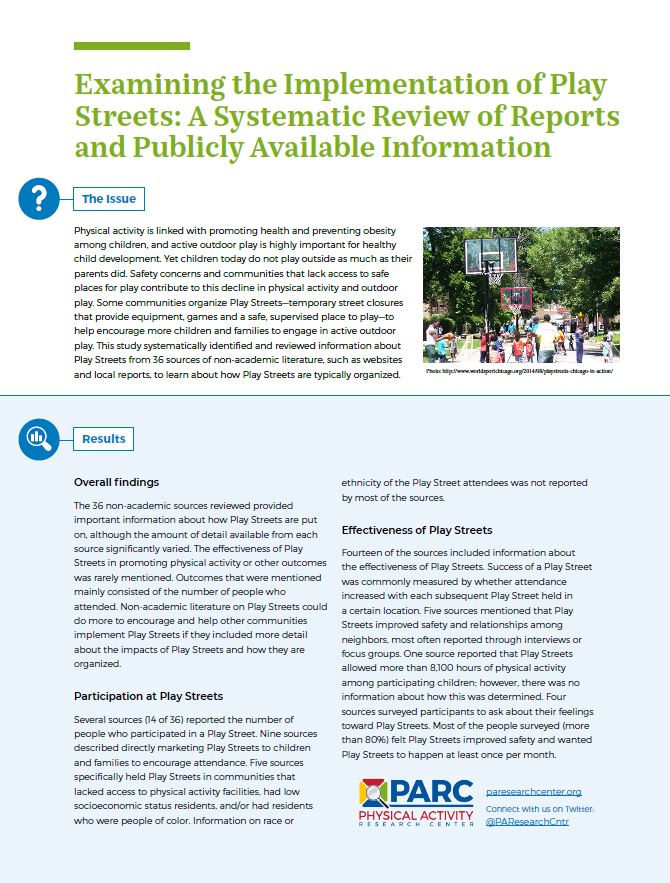Examining the Implementation of Play Streets: A Systematic Review of Reports and Publicly Available Information
By: Christina N. Bridges Hamilton, Tyler M. Prochnow, Emily C. Wilkins, and M. Renée Umstattd Meyer from Baylor University; and Keshia M. Pollack Porter from Johns Hopkins University
Physical activity is linked with promoting health and preventing obesity among children, and active outdoor play is highly important for healthy child development. Yet children today do not play outside as much as their parents did. Safety concerns and communities that lack access to safe places for play contribute to this decline in physical activity and outdoor play. Some communities organize Play Streets—temporary street closures that provide equipment, games and a safe, supervised place to play—to help encourage more children and families to engage in active outdoor play. This study systematically identified and reviewed information about Play Streets from 36 sources of non-academic literature, such as websites and local reports, to learn about how Play Streets are typically organized.
Results
Overall findings
The 36 non-academic sources reviewed provided important information about how Play Streets are put on, although the amount of detail available from each source significantly varied. The effectiveness of Play Streets in promoting physical activity or other outcomes was rarely mentioned. Outcomes that were mentioned mainly consisted of the number of people who attended. Non-academic literature on Play Streets could do more to encourage and help other communities implement Play Streets if they included more detail about the impacts of Play Streets and how they are organized.
Participation at Play Streets
Several sources (14 of 36) reported the number of people who participated in a Play Street. Nine sources described directly marketing Play Streets to children and families to encourage attendance. Five sources specifically held Play Streets in communities that lacked access to physical activity facilities, had low socioeconomic status residents, and/or had residents who were people of color. Information on race or ethnicity of the Play Street attendees was not reported by most of the sources.
Effectiveness of Play Streets
Fourteen of the sources included information about the effectiveness of Play Streets. Success of a Play Street was commonly measured by whether attendance increased with each subsequent Play Street held in a certain location. Five sources mentioned that Play Streets improved safety and relationships among neighbors, most often reported through interviews or focus groups. One source reported that Play Streets allowed more than 8,100 hours of physical activity among participating children; however, there was no information about how this was determined. Four sources surveyed participants to ask about their feelings toward Play Streets. Most of the people surveyed (more than 80%) felt Play Streets improved safety and wanted Play Streets to happen at least once per month.
Adoption of Play Streets
The adoption of Play Streets involves understanding what inspired people to host a Play Street. Twenty Play Streets started from partnerships between community advocacy groups and city departments, including those concerned with physical activity (e.g., departments of parks and recreation). Some sources reported they started Play Streets because other cities had them and multiple sources mentioned Play Streets in New York, which were initially founded by the Police Athletic League.
Characteristics of Play Streets
Seventeen sources described the types of equipment and activities available at Play Streets, including hula hoops, jump ropes, bicycles, and hopscotch. How the equipment was used and by whom was not reported by any of the sources. Thirteen of the sources reported the use of staff or volunteers to supervise Play Streets. Seven sources mentioned the cost of Play Streets, which ranged from $312 for a block party permit to $30,000 to host a Play Street with paid staff.
Continuation of Play Streets
Twenty-six sources mentioned Play Streets that happened more than once, and eight sources mentioned Play Streets that only happened once. Six sources mentioned that the people who organized Play Streets wanted to hold them more frequently and/or increase the number of people who participated in them. Fourteen of the sources mentioned Play Streets were only held during the summer months.
Findings from this lay summary are available in the full article, published in the Journal of Public Health Management & Practice:
Bridges CN, Prochnow TM, Wilkins EC, Pollack Porter KM, & Umstattd Meyer MR. Examining the implementation of Play Streets: A systematic review of the grey literature. Journal of Public Health Management & Practice. 2019. doi: 10.1097/PHH.0000000000001015.
Suggested Citation for Lay Summary:
Bridges CN, Prochnow TM, et al. Examining the Implementation of Play Streets: A Systematic Review of Reports and Publicly Available Information. A Lay Summary. San Diego, CA: Physical Activity Research Center; Waco, TX: Baylor University; and Baltimore, MD: Johns Hopkins Bloomberg School of Public Health; 2019. Available at: https://paresearchcenter.org/examining-the-implementation-of-play-streets-a-systematic-review-of-reports-and-publicly-available-information/.
This lay summary was made possible with funding from the Physical Activity Research Center. The research that generated the lay summary was led by Drs. Keshia M. Pollack Porter from Johns Hopkins Bloomberg School of Public Health and M. Renée Umstattd Meyer from Baylor University.

